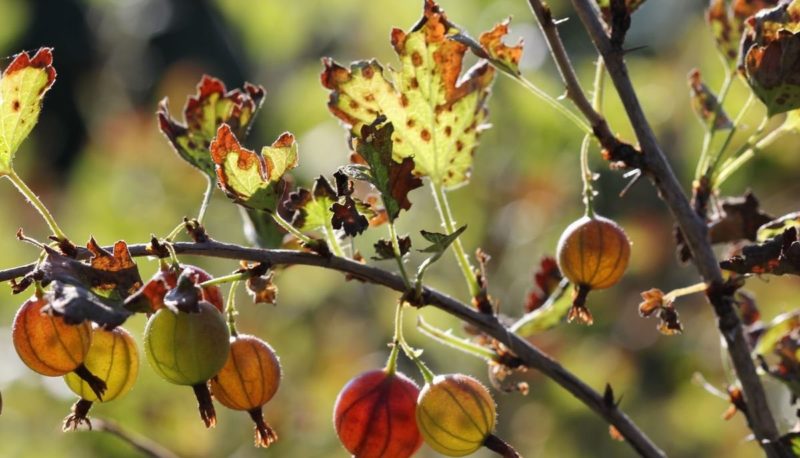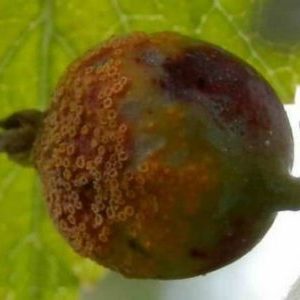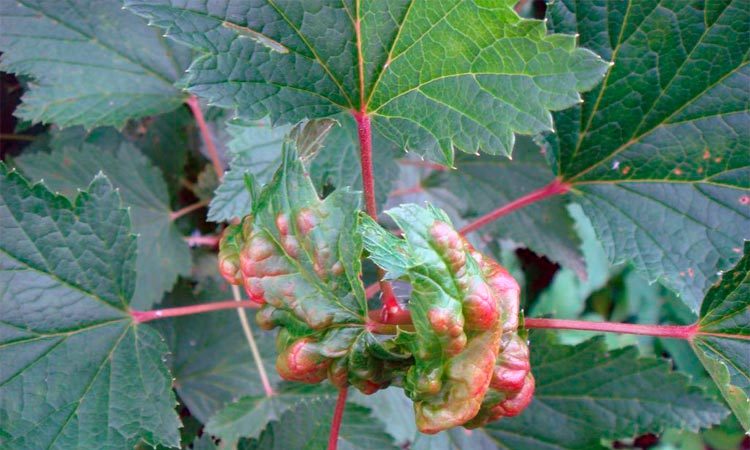Why did gooseberry rust appear and what to do to get rid of it
Gooseberry bushes unpretentious in care. However, for some gardeners, the plant bears abundant fruit without leaving from year to year, while others are constantly fighting pests and diseases. The most common disease in the Russian climate is rust on gooseberries. What to do with pathogens, how to protect shrubs and how to recognize the disease in a timely manner? Detailed answers to these questions are in our article.
The content of the article
Rust on gooseberries - reasons for the appearance
Deformation of the gooseberry leaves, the appearance of red spots on them or fruits indicates the activity of pathogenic fungi of the genus Phragmidium or Puccinia... The people call the disease rust. The disease is quite common and dangerous for the plant. By the degree of harmfulness, gooseberry rust is equated to powdery mildew. If measures are not taken in a timely manner, it can harm all fruitful shrubs and destroy the crop.
Fungal microorganisms live in the host organism under anaerobic conditions. Carriers can be plant debris, weeds or intermediate plants.
For reference. A pile of autumn leaves left in the garden is the most common refuge in which pathogenic microorganisms survive winter period.
With the arrival of spring, spores are carried long distances by wind. Warm weather and high humidity levels stimulate the process of plant infestation.

How to recognize
The spore-bearing stage of development in rust fungi is manifested on the leaves and stems of plants. Infected parts develop brown rusty spots arranged in lines.
Over the summer, they ripen, dry up, and cracks form on them, through which spores pour out, easily spreading to nearby plants.
Among the secondary signs:
- leaf deformation;
- premature plant drying;
- deformed and dry berries.
If the disease is ignored, the gooseberry bush dies after a few weeks or months.
It is recommended to carefully examine the gooseberry planting at intervals of 1 every 7 days.
Types of rust
Gooseberry planting susceptible to two types of infections: columnar and goblet, the latter being more common.
Both types of rust infect gooseberry leaves, but still have distinctive features.
Goblet
On the leaves of the affected plant, orange spots with spore pads are observed. Over time, when opened, spores take the form of small glasses. Light touching or shaking breaks the integrity of the cups and spores can easily spread to other plants.
Fruits with glassy rust are most often deformed, quickly dry out and fall off.
Attention. In this type of disease, sedge acts as an intermediate host, so planting shrubs in places of its accumulation should be avoided.
Columnar
Development peaks in July. It manifests itself in the form of small yellowish spots on the fruits, the upper plate of foliage and yellow-orange growths at the bottom of the plate.
The close proximity of shrubs to cedars and pines in most cases leads to infection, becausethese trees act as intermediate hosts of columnar rust.
How to get rid of the problem
Shoots and foliage with extensive infestation are removed and burned. The remaining bushes require treatment with drugs. First of all, gardeners resort to the help of biological products - they are safe for the harvest and increase the immunity of the plant, additionally nourishing it.
Alternatively, folk remedies are used, but they are effective with a small area of crop damage and timely detection of the pest. In extreme cases, when the above means do not cope, chemicals are used.
Biologicals
Among agrotechnical biological products for individual farms, two funds are allocated.
"Trichodermin"
A harmless and safe preparation that does not affect the taste and nutritional qualities of the crop. The fruits can be eaten on the same day, after treatment with the product. Available in the form of an aqueous suspension and dry powder.
When using a powder, the medicinal composition is prepared according to the following recipe: a package (10 g) is dissolved in 1 liter of warm water, adding the powder gradually and stirring continuously. Then leave for 1-2 hours at a temperature not lower than 15 ° C. The finished solution is used within 6 hours.
Important. Biologicals are unilaterally compatible with chemicals, that is, chemicals can be used after processing microbiological products. But it is recommended to resort to the help of biological products after treatment with chemicals no earlier than 14 days after the expiration of the period of the protective effect of chemical reagents.
"Fitosporin M"
Systemic drug based on spore culture. It is used at any stage of plant development. The manufacturer guarantees the safety of the crop product even on the day of processing. It is sold in the form of an aqueous suspension, powder and paste.
The plant is treated with "Fitosporin" exclusively in cloudy weather or after sunset, as the product does not tolerate bright sunlight. The powder is diluted 2 hours before processing, strictly according to the instructions. When using a paste, a concentrated solution is prepared, which is diluted before processing.
If the mixture is being prepared for spraying, then liquid soap can be added to it at the rate of 1 ml per 10 liters. This will ensure better adhesion of the drug.
For reference. Fitosporin is diluted exclusively in boiled, melt or rain water. The chlorine content of tap water is detrimental to the bacteria contained in the preparation.
Traditional methods
Of the many popular methods, gardeners most often practice processing with ash, baking soda, soda ash, soap and boiling water. These methods are completely harmless, but not always effective. It is more rational to consider them as preventive measures.
Boiling water
Only a dormant bush is processed, immediately after the snow melts. If the kidneys are already swollen, this treatment is not suitable. In order for the infection to die, and the bush to remain unharmed, it is recommended not to water, but to spray boiling water.
Thoroughly moisten all the shoots, but do not overdo it, as there is a high likelihood of premature flowering of the bush. You can enhance the effectiveness of boiling water by adding soda or salt to it (3-5 tbsp per bucket).
Baking soda and soda ash

An alkaline product is harmful to microorganisms. Use it before bud break. To prepare the solution, dissolve 100 g of baking soda in 10 liters of water.
Attention. Soda ash is more aggressive, so its dosage is halved (50 g of substance per 10 liters of water).
Laundry soap
Another product with an alkaline reaction, but more effective than soda, because covers the surface of the plant with a protective film.
To prepare the solution:
- Grate 50 g of soap.
- Pour 2 liters of boiling water and stir.
- After complete dissolution, add another 8 liters of water to the concentrate.
- Start processing.
Ash
It is used both to combat microorganisms and to feed the plant. There are many recipes, they all differ in proportions and technologies: from 100 g to 1.5 kg per 10 liters of boiling water. Pour, leave for several days or boil for 10-15 minutes, drain and water.
This method is the most controversial among gardeners due to the difference in the compositions of the raw materials burned. Among the disadvantages is the rapid loss of alkaline properties due to many factors (storage in a damp room, the remnants of a fire got wet in the rain, etc.). In this case, it is more expedient to use ash as a soil loosening agent.
For reference... You can check the alkaline environment of the ash using litmus paper. If the pH is more than 7-8, then ash treatment will be effective.
Chemicals
These are broad spectrum fungicides that require precautions. For safety reasons, use only certified drugs, work in overalls, cover your nose and mouth with a gauze bandage.
Start spraying after removing damaged areas and eliminating them, do not use the same chemical on an ongoing basis, especially since there is a considerable list on the market.
"Abiga Peak"
Aqueous suspension based on copper oxychloride. The solution is prepared strictly according to the instructions, processed by spraying. First, a mother liquor is prepared. The bottle is diluted with 1 liter of water. Then add another 10 l to the solution and mix thoroughly. Use the product immediately, you cannot store it. Bushes are processed in 2 stages with a frequency of 20 days.
The weather conditions do not matter, but the air temperature must be at least + 9-11 ° C.
Bordeaux mixture
Consists of copper sulfate and calcium hydroxide. Powders are diluted in separate containers for ¼ part of water, then added with water to the required volume. Constantly stirring, calcium hydroxide concentrate is introduced into the copper sulfate solution. The product is not stored and used immediately after preparation. Processing is carried out in three stages with a frequency of 25 days.
"Topaz"
Highly effective fungicide based on penconazole. It is not phytotoxic, it remains in the soil for a long time. The active ingredients are quickly absorbed by plant tissues, which does not tie the use of the drug to weather conditions. It is sold both in a large volume - emulsions of 1 liter, and in ampoules of 2 ml.
One ampoule of the concentrate is diluted in 10 liters of water. The solution is used immediately after preparation. During the season, 3-4 irrigations are enough with a frequency of 21 days.
"Hom"
Powder containing copper oxychloride. Recognized by gardeners as an excellent substitute for Bordeaux mixture. It is used in calm weather, in the period with the least probability of rain. On average, 40 g of the drug is designed for 10 liters of water.
To begin with, the powder is dissolved in a small amount of liquid, then, by adding water, it is brought to the required volume with constant stirring. Gooseberry bushes are processed twice: before and after flowering.
Agrotechnical techniques
Correct agricultural technology will prevent many problems. Timely created starting conditions for the growth of gooseberries will allow you to grow an excellent harvest, but it is necessary to observe the planned measures from year to year:
- Crop rotation. It is important to take into account the timing of the preservation of pathogens in the soil.
- Removing weeds from the site before planting.
- Correct soil cultivation.
- Compliance with the terms of planting and harvesting.
- Application of organic fertilizers.
If rust is a common disease in your area, it is advisable to grow crops that are resistant to it.
How to deal with rust properly

To save the harvest, it is important to know not only the list of effective drugs, but also the rules for the treatment, the scheme and timing of the treatment of bushes.
Universal Tips:
- Drug treatment begins at the first sign of illness. The interval is 1 time in 10-12 days.
- If after processing the bushes within 5 hours it rains, the procedure is repeated.
- Irrigation of gooseberries is best done in cloudy weather or in the evening.
- Carefully process not only the upper part of the leaves, but also the lower one.
To defeat the infection, one treatment is not enough: in the spring, when the leaves are blooming, the gooseberries are irrigated with 1% Bordeaux liquid, after flowering and after another two weeks, the treatment is repeated. The last spraying is carried out after the harvest.
Rust resistant gooseberry varieties
The varieties that are resistant not only to gooseberry rust, but also to other diseases are in special demand among gardeners.
- Krasnoslavyansky;
- Chernomor;
- Amber;
- Invicta;
- Isabel;
- Negus;
- African.
Each of the varieties has fundamental differences, so it's up to you - to plant exceptionally resistant varieties or fight for your favorite and familiar crop.
Preventive measures
Preventive measures to prevent rust on berries and leaves include:
- planting infection-resistant varieties;
- prevention of thickening of plantings and timely pruning of shrubs;
- disposal of fallen leaves;
- annual autumn digging of soil on the site;
- avoidance of proximity with sedge and its timely mowing;
- strengthening the plant's immunity with top dressing;
- neat watering of the bushes without getting water on the leaves.
It is also recommended with the onset of early spring, when the temperature is above zero, to destroy the overwintered pathogens with boiling water.
It is interesting:
How to properly freeze gooseberries for the winter in the freezer: the best ways.
How to properly freeze basil for the winter: a selection of the best ways.
When and how to plant honeysuckle in autumn and what mistakes to avoid during planting.
Conclusion
As practice shows, gooseberry varieties have not yet been bred that would not be ill with any diseases. Therefore, it is important to properly care for and monitor the health of the shrubs. Timely detection of diseases will eliminate the use of aggressive drugs and save the harvest with the help of folk remedies.